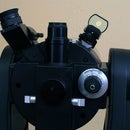Introduction: Meade ETX 125 Telescope Heavy Electrical Wiring Mod
This modification intent is to address several electrical wiring issues discussed on the great online resource of Mike Weasner: http://www.weasner.com/etx/menu.html
The main issue is actually: "Too many hanging cables!"
In particular:
-The DEC motor cable had been removed from the RA axis hole. Thus allowing to remove the RA axis hard stop mechanism. This helps a lot during the initial alignment of the telescope, and during long observation sessions guiding. It is also helpful for the scope tuning, which requires disassembling of the base.
- The serial port signal is routed from the AutoStar box to the base of the scope and then to the top of the right arm of the fork to accept the BlueTooth transmitter for remote control and/or GPS connection.
- The Aux port and a couple of simple 2 wire power plugs for the auxiliary peripheral devices are conveniently mounted on the same fork arm to shorten the required cabling and preventing them from tangling around the scope.
Step 1: The Parts and Tools
I've got several RJ45 and RJ14 plugs, an RS-232 male connector, a couple of 3.5mm mono audio plugs, and a roll of color coded wire band. Also I've found in my garage a coiled telephone handset cord to connect to the AutoStar serial port.
I've used a Multimeter, a soldering iron, a hot glue gun, a Dremel tool, an Utility knife, some files and drill-bits. The scope's plastic is very easy to deal with.
It's nice to have a soft brush and a a vacuum cleaner at hands to remove the accumulating shavings often. Wear safety glasses working with Dremel (or any other rotary) tool.
Step 2: Removing the RA StopDEC Motor Wires
Pictured: the straight wired retractable network cable.
That cable can still be purchased (2016) off eBay for $1 or so. It's very light weight, and retracts/extends automatically in response to the scope's RA/Azimuth movement:
This step, as far as some other tweaking to the telescope, which you can perform along the way, are perfectly covered by Bob here in "My DEC cord mod" section. The wiring diagrams and connectors pinouts was taken from this site, and this site (The LX90 PCB layout is very close to the ETX125's except the voltage of ETX is 12V vs. 15V for LX). And/or retrieved in place by a multimeter.
I have nothing to add to this step (which is actually the most thrilling part of the procedure), except that in my case I've decided to use the 8 pin retractable network cable and the RJ45 jacks instead of RJ14's to connect the base to the right fork arm. Also the hot glue works here as well as the epoxy. Everything else was done by exactly following Bob's excellent instructions. The other 4 connectors of the RJ45 was used to route the Aux port signals (Clock, Data) and RS232 port signals (Rx and Tx).
Step 3: Right Fork Arm
Pictured: The right fork arm open.
Here is the right fork arm with all of the wires in place. You can see the RS232 connector on the top side with the pin 9 connected to the 12V wire to power the BlueTooth adapter; two mono audio connectors lower on the scope's front and back sides (left and right); and the standard Meade Aux connector (RJ14) on the lower back side. The tiny PCB board on the right top side of the image is a simple wire distribution measure, which allows easy resoldering of the wires, as far as adding new ones as necessary in the future.
I've used quite a stiff wires, which holds the shape very well. But it's easy to hot glue them to the sides of the fork box to hold in place. The connectors are hot-glued in place.
It's wise to install all of the DEC gears prior to the marking of the positions for your connectors. Some of the places are not easy to reach or will interfere with the gears or their mountings. So choose wisely.
Step 4: The Base Wiring
Pictured: The bottom fork mount compartment open.
The fork base box modification procedure is pretty much the same. An additional RJ14 connector had been installed right below the scope connectors board, closer to the AutoStar connector. It will provide the connection to the AutoStar's serial port.
The second image shows this board and some additional wires soldered right to the back of the PCB, to the contact plates, it's not possible to reach the front side of the PCB. The green and yellow wires are connected to the AUX connector data pins, the brown wire is signal Ground (negative), the red is positive. The power wires were later equipped with a 2 wire inline connector taken from a PC cooling fan to allow easy disconnection of the battery holder along with the bottom lid.
Step 5: Outside Wiring
Pictured: The mount is rotated 180 deg in azimuth.
The telephone handset cord could be "reversed" (turned inside out) to match the coiling direction of the main AutoStar cable. After that it's easy to "thread" it inside like on the picture for a neat look and feel. I've preferred the white color to make the cable more visible in the darkness.
Step 6: Final Thoughts
Mouse-over the image for the end result explained.
- Prior to installing the batteries make sure you've checked that everything is right and connected properly with the Multimeter _several_ times !!!
It's easy to fry out your motor controllers.
- Brush and vacuum everything inside the fork mount after each operation. Double check gears for the chips and shavings left prior to the final assembly.
- Watch the soldering iron and the hot glue gun all the time to prevent accidental melting of the plastic parts you don't want to melt. Use high heat settings if possible and operate these instruments in quick touch manner.
- Use a soft pencil to mark everything.













